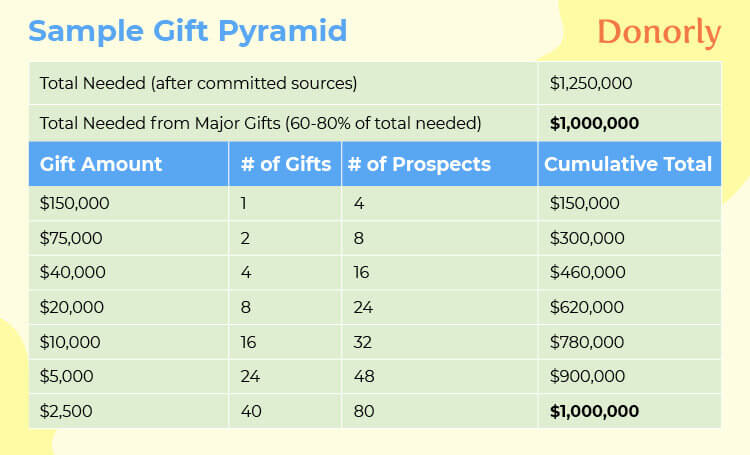6 tactics for excelling at fundraising campaign planning
The key to fundraising success lies in effective planning. But while every nonprofit relies on fundraising campaigns to secure the funds it needs to further its mission, planning successful campaigns can feel especially vital—and as a result, more intimidating—for smaller organizations.
But it doesn’t have to be! With the right mindset and fundraising planning skills, your team can build a solid foundation for every campaign you launch. We’ll explore six campaign planning tips you can use to hone your skills and develop thorough fundraising strategies for your nonprofit again and again. Let’s get started!
1. Revisit past campaigns first
Before you dive headfirst into planning a new campaign, take time to reflect on and learn from your past experiences. Revisit the campaign materials, engagement metrics, and results of your previous campaigns to see how you approached fundraising and how you could improve.
As you explore these resources and the past campaign data in your CRM, ask yourself these questions:
- Which fundraising tactics were successful?
- What were your team’s biggest challenges?
- How did you engage donors?
- Did your communication strategy resonate with donors?
- What steps did you take to acquire new supporters?
- Which donors gave the largest contributions? How did you secure these gifts?
- What was your overall return on investment (ROI) for the campaign?
- What is the typical cost per dollar raised (CPDR) for different campaigns or events?
Additionally, meet with your core fundraising team along with any volunteers who played a part in past campaigns to discuss their experiences. They can provide more detailed insight into their challenges, how they overcame them, and what they would do differently this time. Starting your campaign planning with this context will set you up for greater success and ultimately grow your nonprofit’s fundraising capacity.
2. Understand the different campaign goals you need to set
Fundraising campaigns aren’t only about raising money. While earning revenue for your cause is the main goal, campaigns are also great opportunities to build community with your donors and other participants, gain a better understanding of how they want to connect with your organization, and so much more. This is especially true for major initiatives like capital campaigns which may span multiple years.
Because of this, it’s important to set more than just a topline fundraising revenue goal. Choose a few strategic areas you want to improve with your campaign, such as donor retention or supporter engagement with events. Based on these strategic areas, set smaller goals for the campaign, such as:
- Increase donor acquisition by 10%.
- Boost fundraising event attendance by at least 50 people.
- Build relationships with five new major donor prospects.
- Add at least 100 new contacts to your nonprofit’s email list.
Refer back to your organization’s strategic plan and current overarching priorities if you’re not sure what to focus on. How can this campaign support those organizational goals? How can you measure progress? Set specific, achievable goals based on these priorities.
3. Leverage fundraising planning tools
There are many simple but highly effective planning tools to keep your campaign organized without adding costs to your budget, like a gift pyramid or a stewardship matrix. You can easily create both of these resources so they can be highly personalized and accurate to your organization’s donor base.
A gift pyramid is a basic chart that helps you break down how many gifts you need at different giving levels to reach your topline fundraising goal. Donorly’s fundraising plan template provides the following sample gift pyramid for a major campaign you can use to inspire your own:

Use this tool to guide your donor research and cultivation efforts. For instance, since the sample nonprofit above knows it needs at least one $150,000 gift from a major donor, it might focus on four prospects with the potential to give a major gift of that size.
A stewardship matrix, on the other hand, helps guide your donor acknowledgment and retention efforts after you secure these gifts. Stewardship is crucial for maintaining donor relationships and keeping them invested in your mission long-term, so it’s important to build these efforts into your campaign plan from the beginning.
4. Prioritize major donor research and cultivation
Major giving often makes up 60-80% of the total revenue for large-scale fundraising campaigns, making it a crucial part of any campaign plan. Use your gift pyramid to calculate how many major gifts you need to reach your fundraising goal, then set smaller goals to identify and cultivate more major donor prospects than you need.
In your campaign plan, outline how you’ll approach each part of major donor fundraising to reach these goals. This includes:
- Prospect research: Determine what tools and strategies you’ll use to identify, research, and verify prospects who have the potential to give gifts above your major gift threshold.
- Creating personalized cultivation plans: Develop step-by-step plans for building relationships and trust with each of your prospects before you make an ask.
- Major gift solicitations: Outline guidelines for when and how to ask prospects for a major gift, and determine who should manage this process.
- Acknowledgment and stewardship: Include a section in your stewardship matrix that defines how to thank, acknowledge, and retain major donors.
Research and cultivation are important since they pave the way for successful major gift solicitations. Plan to devote plenty of time and resources to these processes. If your team doesn’t have enough resources or experience to handle the process confidently, consider engaging a nonprofit consultant who can help (and be sure to allocate room in your budget for their services).
5. Keep your timeline flexible
It’s normal to want to define exact dates and deadlines for all your key campaign activities so you stay on track, but be mindful that your timeline may need to change throughout your campaign. To be flexible, consider mapping general periods or benchmarks instead of concrete dates at first—especially if you’re planning a time-intensive capital campaign.
For example, you might plan to spend six months to a year in your campaign’s quiet phase and aim to announce the campaign publicly by July 2025. With a looser timeline like this, it’s easier to adapt if you secure enough donations earlier or later than expected.
Keeping your timeline flexible leaves you better prepared to weather the unexpected. It also leaves more room for experimentation and any new ideas that may arise during the campaign.
6. Put yourself in your donors’ shoes
Finally, make sure that you consider your donors at every stage of the campaign planning process.
Refer back to the research you did earlier, your past campaign results, and the information in your database to dive deeper into donors’ habits and put yourself in their shoes. What aspects of past campaigns resonated with them most? What are their top charitable priorities right now? Take time to understand their values while avoiding complete donor-centrism.
In particular, consider donors’ perspectives as you create your campaigns:
- Case for support: For capital campaigns, your case for support is the document that outlines exactly why donors should invest in your campaign and how it will help you create meaningful community impact.
- Fundraising appeals: Appeals are more likely to inspire donors to give if the messaging is personalized and highly relevant to donors’ interests.
- Marketing plan: Defining your priority audiences and their motivations for giving is one of the most important parts of a nonprofit marketing plan.
Your donors’ support will help make your nonprofit’s goals a reality, so it’s crucial to tailor your fundraising campaigns to their interests, motivations, and communications preferences, while also holding the needs and priorities of the rest of your community in mind.
Excelling at campaign planning is an ongoing process, but it’s a worthwhile endeavor that will greatly benefit both your nonprofit’s future and your fundraising skillset. Don’t be afraid to ask for support as you try out these tactics, whether from seasoned professionals at your organization or an outside expert who can provide more in-depth training.
About the author: Sandra Davis is the Founder and President of Donorly, where she brings 30 years of fundraising experience and leadership. Sandra has consulted on numerous capital campaigns, led strategic planning and feasibility study efforts, and managed board development and recruitment efforts in addition to overseeing planned giving, special events, and annual giving programs. Under her leadership, Donorly has grown to support the fundraising efforts of over 75 clients.





